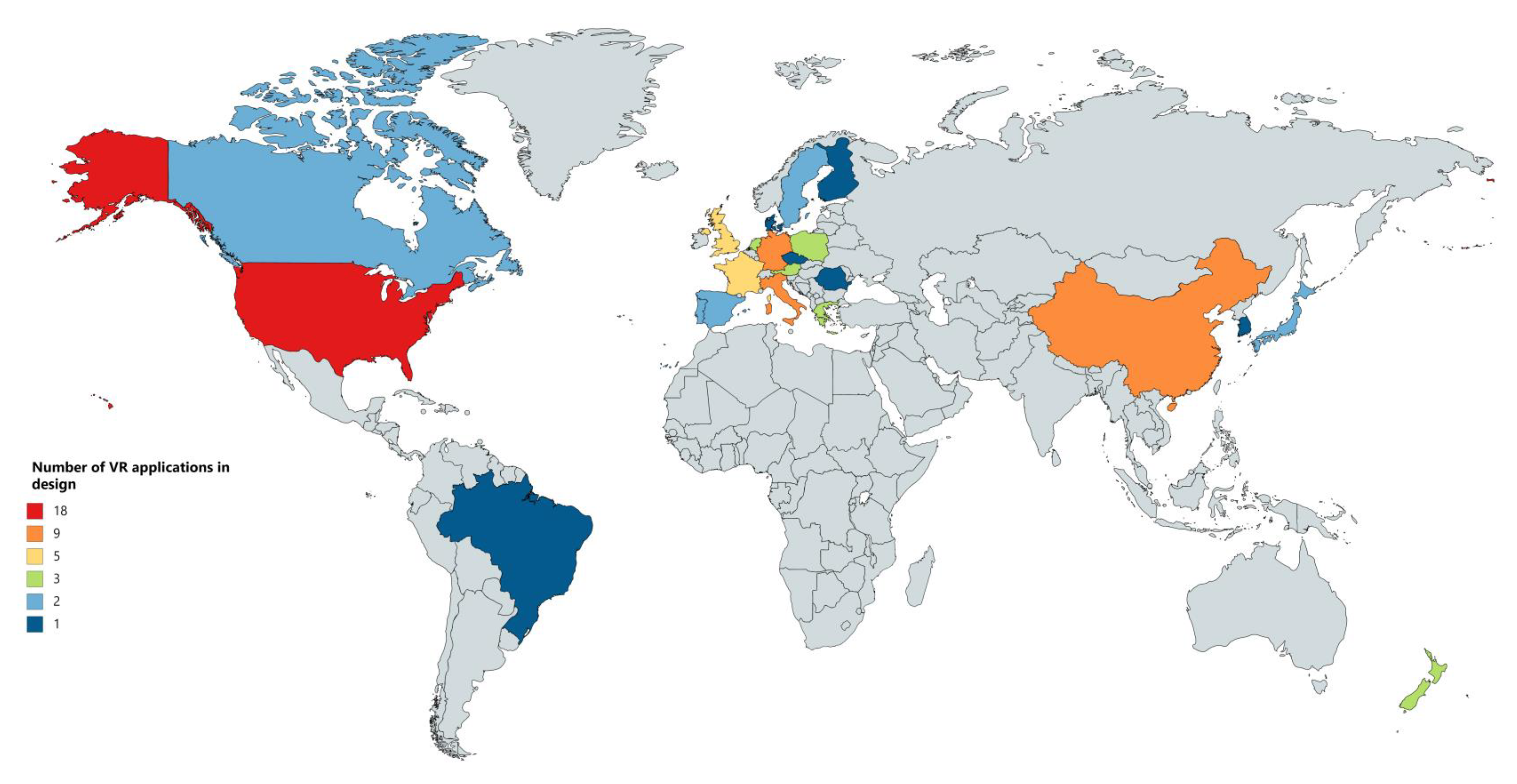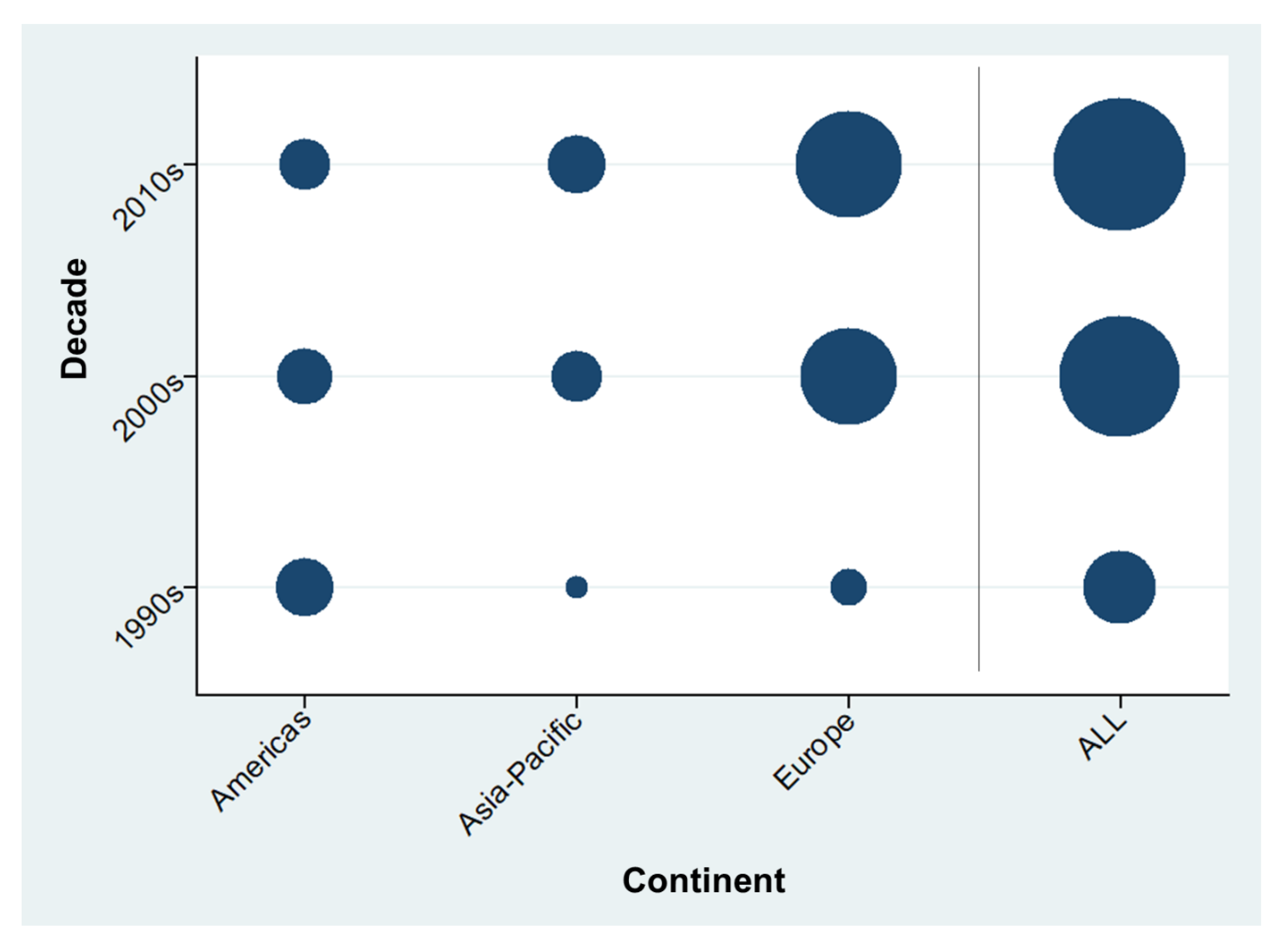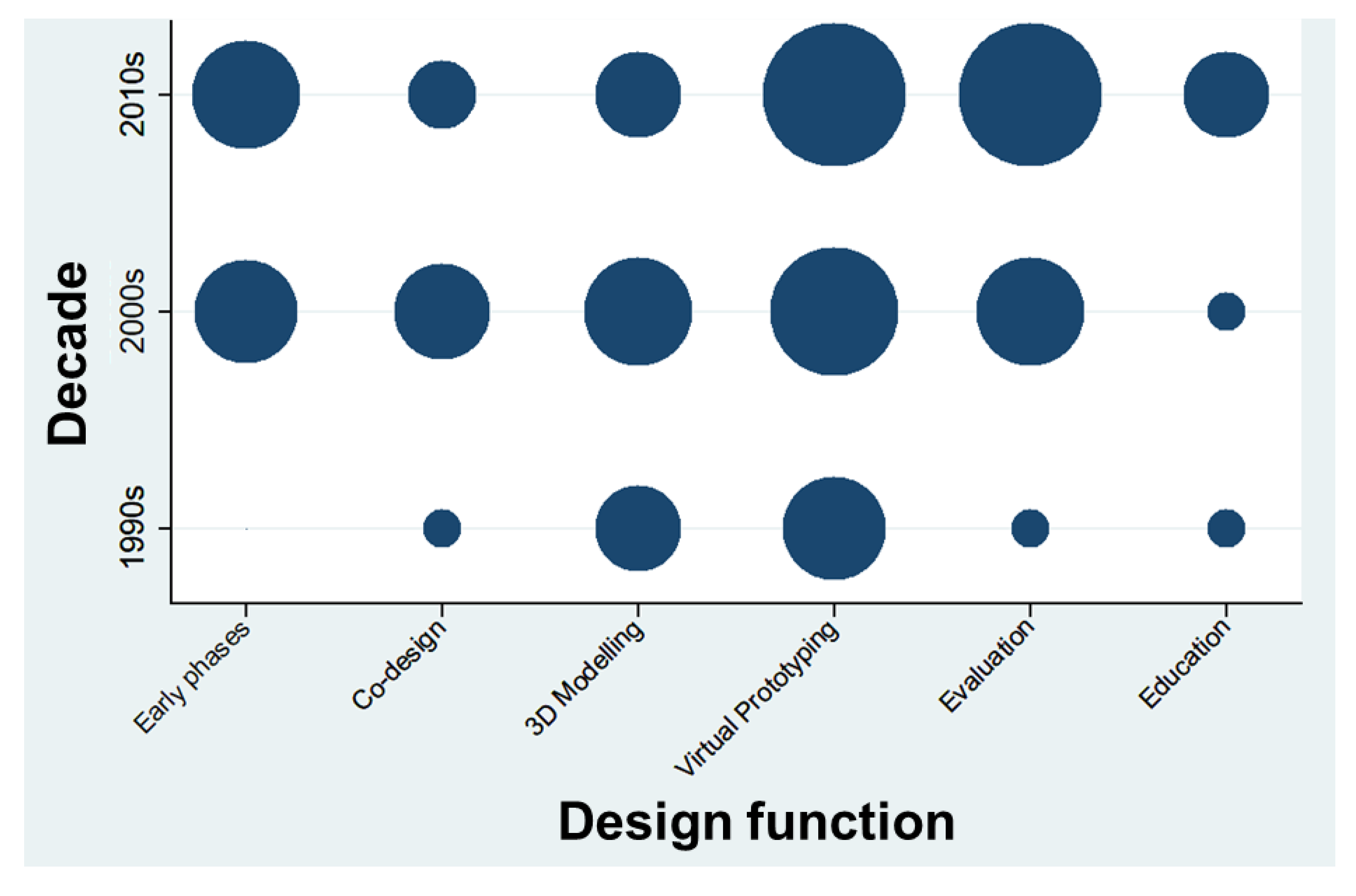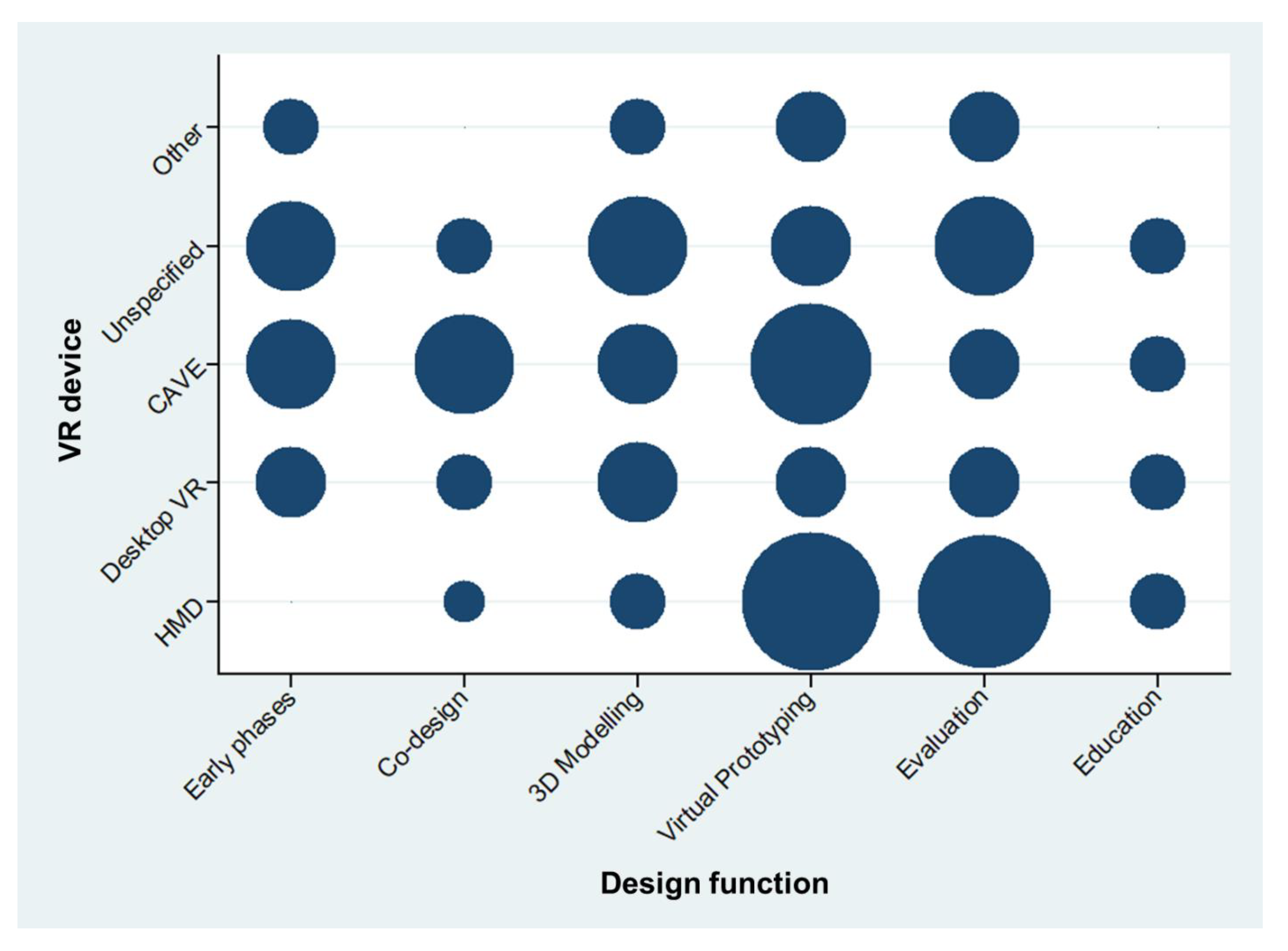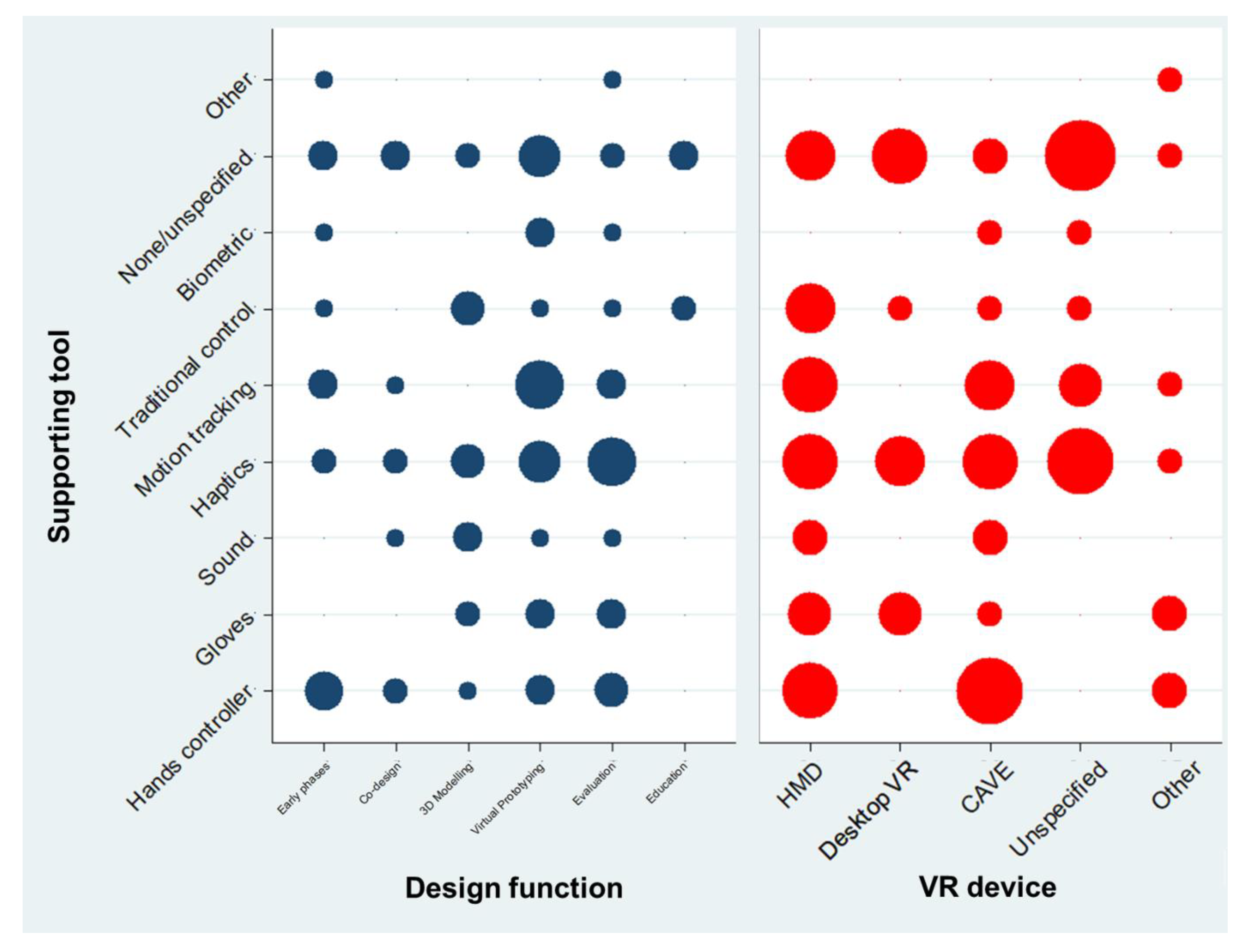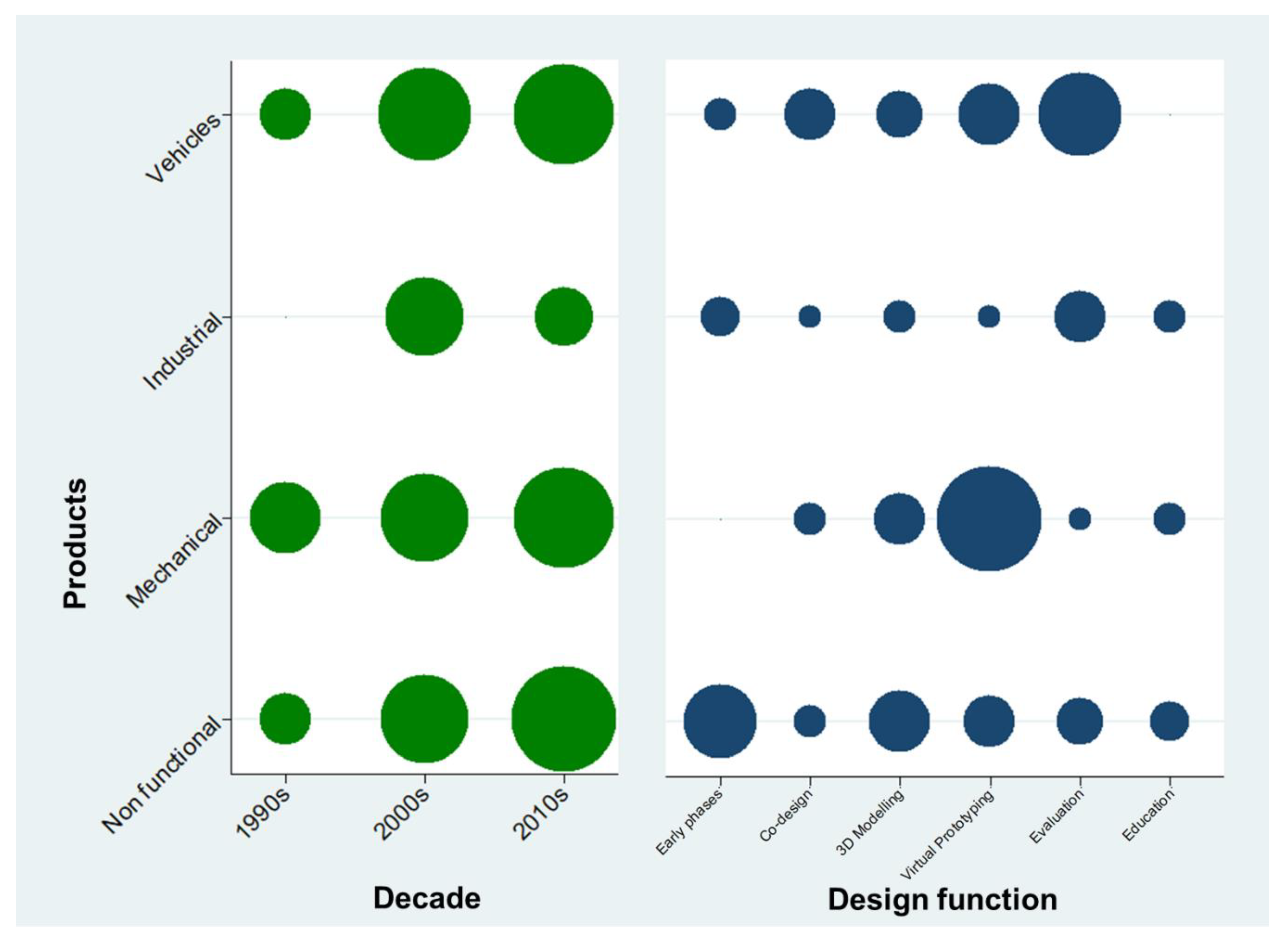2. Background and Objectives
When it comes to the application of VR in design, the contribution authored by Ottosson [
7] can be considered a milestone, ascribable to the VR phase prior to large-scale development. It underlines the necessity to investigate how to implement this technology for real case studies, by outlining VR’s potential for supporting a great deal of design activities. In particular, the scholar saw the chance of VR’s supporting the initial design phases beside those that are “more naturally” juxtaposed to VR, namely, 3D modeling, virtual prototyping for simulation, and product evaluation.
VR’s actual capability of supporting different functions in design, starting from those individuated by Ottosson [
7] at the dawn of the third phase, is the main issue dealt with in the present paper. Other contributions ascribable to the third and fourth phases highlight how different design activities can exploit VR’s capabilities advantageously.
Some scholars underlined the versatility of VR with respect to different design functions and stressed the importance of implementing VR systems in every phase of the process, using the right software and VR devices in the appropriate design stage [
15,
16]. On the contrary, others focused more on using VR for particular applications. For instance, Cecil and Kanchanapiboon [
17] and Camburn et al. [
18] underlined the importance of using VR in the early design phases, where design problems can be better detected through VR, with consequent improvement in the quality of the product and reductions in its development time and cost. Stark et al. [
19] and Falcão and Soares [
20] stressed the usefulness of VR systems for product evaluation due to the introduction of VR interfaces related to human interaction with virtual prototypes. Zignego and Gemelli [
21] emphasized VR’s usefulness for simulations while casting doubts on its potential for aesthetic evaluation of the product.
In some of the analyzed articles, scholars considered also the degree of immersion and its use in combination with additional technologies and tools to provide a realistic sense of presence in the virtual design environment. As such, Stark [
19] claimed that VR had matured enough to stimulate users’ sensory immersion, providing increasingly realistic interaction and experience with a virtual prototype. Conversely, other scholars considered this technology as a complementary tool only, since it needed to be integrated with physical objects and haptic systems to give an acceptable sense of immersion [
18,
22,
23,
24]. In particular, since the sense of touch is an important aspect to be considered when it comes to the VE, using a real object as tactile feedback could enable complete manipulation control in the immersive VE [
25].
The above examples show that a comprehensive view of the advantages unlocked by VR in design is still lacking. In many cases, scholars focused on specific functions within design without providing an overall picture. A larger overview can help us to analyze how different design functions are supported by VR and how they can actually benefit from the different degrees of immersion and additional tools. Many of the most recent reviews provided in the literature where VR technology has been analyzed had a different focus or a different aim, as illustrated below.
Rebelo et al. [
26] studied VR devices and their corresponding degrees of immersion, but when they analyzed how VR systems can be used in design, they limited their work to user-centered design. Jimeno and Puerta [
27], whose contribution is relatively dated, studied VR to understand its importance, benefits, and developments only in combination with CAD and Computer-Aided Manufacturing technologies. Similarly, Berg and Vance [
28] limited their attention to decision-making processes in order to empower industry innovation. Although Kovar et al. [
29] extended the field of research to other design processes, this took place only in relation to VR’s contribution to Industry 4.0. Adenauer et al. [
15] investigated more explicitly the potential of VR in design. However, in this paper, virtual prototyping was included in the early conceptual phases, which is questionable since a developed virtual model is usually considered a means for evaluation in other papers. Coburn et al. [
30] showed a number of cases in which VR was used to support different design activities, but those were predefined and there was no claim of comprehensiveness.
Hence, a framework is lacking that systematically maps the functions VR actually supports in the design process. Markedly, while some functions and phases have been made explicit in a fragmentary way, no previous contribution has given an overall picture. This leads to the need for an overview of the applications of VR in the various design functions and activities, although those might be plausibly characterized by an uneven distribution. Likewise, an accurate relationship between VR devices and the design phases where they have been used has not been established.
Starting from this context, we aim to map the reasons for the use of VR in design and the activities supported, which will be grouped into VR functions. Along with the verification of the actual growth of VR applications in design pushed by VR’s maturity, the aspects that follow are of particular interest and worth investigating.
In order to address the above points, the methodology adopted by the authors was the gathering of relevant documents showing VR applications in design and the subsequent classification of these contributions according to multiple criteria.
The remainder of the paper is structured as follows.
Section 3 describes how the search for documents showing VR applications in design has been carried out, along with selection criteria.
Section 4 illustrates classification criteria and corresponding categories.
Section 5 presents and discusses the main outcomes of the study in relation to the above bulleted list.
Section 6 draws conclusions and indicates the limitations of the present paper.
3. Gathering of Relevant Sources Describing the Application of Virtual Reality in Design
According to the above literature gaps and research aims, the present paper is intended to define a comprehensive set of design functions supported by VR thanks to its immersive capabilities. As aforementioned, the investigation was carried out by means of a literature review focused on VR applications in design, which were subsequently characterized through bespoke taxonomies.
The first step was therefore to collect contributions describing the use of VR in the design process. The article search was conducted using Google Scholar between December 2019 and January 2020. Two groups of search terms (below) were used to search the full texts of scientific papers.
A group of terms ascribable to virtual reality technology, e.g., “Virtual Reality”, “VR”, “immersive reality”, “immersive environment”, and “virtual prototyping”.
A group of terms referring to the design domain, e.g., “design”, “product development”, and “user experience”.
At least one term from each group should be present in the papers’ text, as better inferable from the illustrative queries included in
Figure 1, which shows the process leading to the selection of relevant sources. The consultation of documents emerging by means of each query was interrupted when the gain in terms of the number of new pertinent contributions was very low and additional efforts would have benefitted the present research to a limited extent. The sample was also extended through a snowballing process and with additional articles published after January 2020 thanks to the ongoing monitoring of the most relevant outlets for design research.
Relevant sources were considered those featuring the following characteristics.
The documented and unambiguous use of VR technologies; for instance, studies that just cite or theoretically discuss the employment of VR were discarded. In addition, papers were excluded when they claimed to involve immersive VR but, after a careful analysis, the technology was determined to be not immersive.
Their focus on design; here, the term “design” encompasses those product development activities described in established descriptions of design processes [
32], along with their management and scientific/academic divulgation. Therefore, the mere use of VR in industry, e.g., the enhanced visualization of manufacturing facilities by means of VR, was not considered a sufficient inclusion criterion, as no design-related activity was actually supported. Markedly, this led us to select relevant contributions within the domain of engineering and product design, which represent the backbone of design fields according to the framework by Dykes et al. [
33]. More specifically, the field of research was limited to what can be creatively designed and subsequently manufactured. For instance, while novel decorative architectural elements were considered relevant, this did not apply to the organization of environments, spaces, or the arrangement of standard furniture parts in rooms. These inclusion/exclusion criteria favored the subsequent classification of product typology undergoing design supported by VR.
The final sample of relevant contributions consisted of 86 sources, as shown at the bottom of the PRISMA diagram in
Figure 1. The gathered 86 documents represent the reference literature on which the subsequent steps of the study were articulated. The list of selected sources can be found in the next section along with a detailed description of the applied classifications.
4.2. VR Technologies Involved
The necessity to map employed VR devices emerged in
Section 2; here, the level of immersiveness featured by VR technologies might represent a critical factor to benefit design. More specifically, since VR technologies are very heterogeneous, their usability and the degree of the sense of immersion and presence could affect the user during the virtual experience. Therefore, it is likely that these factors could play a fundamental role in the effective application of this technology in the design process. As such, the gathered VR applications were classified according to categories of VR devices.
In this subsection, we refer only to those devices for the visualization of the VE. Any support tools for interaction with virtual prototypes are described in
Section 4.3.
Markedly, three reference types of VR technologies have been identified and considered here for the selection and subsequent classification of VR applications, i.e., head-mounted displays (HMD), the CAVE system or similar devices, and Desktop VR with stereo glasses for 3D visualization. These technologies involve the use of different devices that enable immersion (although to different degrees), in line with Rebelo’s [
26] taxonomy of VR systems, which we benefitted from.
Table 3 summarizes the three main technologies taken into account and indicated as macro-categories; each of them is accompanied by a description of the devices that are ascribable to the reference technologies. In some contributions, the used VR technology was not inferable (unspecified VR system), and other devices have been individuated that cannot be reconsidered within the three reference technologies.
4.6. List of Gathered Contributions and Classification Thereof
The complete list of gathered sources of VR applications in design is presented in
Table 6, along with the categories assigned with reference to the above classes. Unsurprisingly, each contribution might be associated with more entries in virtually any of the considered classes, e.g., an application in which more design activities are supported. All these cases include the sign “&” in the corresponding cell of
Table 6. In addition to the classes described in
Section 4.1,
Section 4.2,
Section 4.3,
Section 4.4 and
Section 4.5, we have indicated the publication periods of the gathered contributions, which is relevant for the research questions posed in
Section 2.
In addition, the publication year of each contribution was used to individuate the reference decade ascribable to the VR application; in detail, the 1990s (1991–2000), 2000s (2001–2010), and 2010s (2011–2020) can be approximately linked to the second, third, and fourth phases of VR evolution, respectively. Finally, in order to provide information on the geographical areas in which research on VR-supported design applications took place,
Table 6 includes a column named “Country”. The reported country matches the affiliation of the corresponding author of each contribution; in the case of multiple affiliations, the first one was considered.
Figure 2 presents a world map that highlights the number of publications for each country. The geographic distribution of VR-supported design applications was subsequently organized into three different areas, namely, the Americas (USA, Canada and Brazil), Asia-Pacific (China, Japan, South Korea and New Zealand), and Europe (all the other countries exhibiting at least one contribution).
5. Results and Comments
The results presented in
Table 6 were analyzed in order to gain insight into the issues that supposedly require investigation, as shown in the numbered list in
Section 2. The subsections that follow are also organized based on this numbered list. Each subsection reports on the specific aspect that is taken into consideration.
5.1. Diffusion of Virtual Reality in Design-Related Applications
In
Figure 3, the number of selected sources per publication year is shown (the year 2020 was not included, as these data could be largely misleading).
Figure 3 includes the reference decades and VR development stages. As already mentioned, the intensity of research is considered here as an indicator of the extent of interest in and relevance of a specific topic. Among the 86 gathered sources, 12, 34, and 40 are ascribable to the second (1990s), third (2000s), and fourth (2010s) stages of VR development, respectively (see also
Figure 4 on the right-hand side). Therefore, by also considering the anecdotal increase of scientific publications in the last few years, the level of maturity reached by VR in the 2000s can be considered the most critical one for unlocking widespread employment of VR in design research. The number of VR applications in design might also be affected by the simultaneous development and diffusion of competitive systems, e.g., mixed and augmented reality. Thus, a complete picture of the limited expansion of VR use in design might benefit from similar studies in neighboring fields. A different explanation is provided below.
Indeed, an interesting aspect that can be inferred from
Figure 3 is the larger number of contributions found in the final halves of the three considered decades compared to the initial ones. It might be assumed that the technological advancements VR has exhibited have been exploited in design research with a few years’ delay. According to this key of reading, the actual number of applications benefitting from the fourth VR development stage should be assessed in the next four to five years.
The time distribution of the selected contributions across the three continent groups considered here is shown in
Figure 4. Interestingly, while the number of contributions has steadily grown in Asia-Pacific and Europe, the interest in VR applications in design has progressively diminished in the Americas. Despite the USA being overall the most prolific country within the collected sources, the overwhelming majority of contributions came from Europe (50 out of 86) if the continental instead of national scale is considered.
5.2. Design Functions Supported by Virtual Reality
The indications from seminal and mature studies on the uptake of VR in design [
7,
30] have well addressed the main areas for the use of these technologies. Based on the design functions and scopes classified in
Section 4.1, the distinguishable design stages that have shown support by VR technologies are actually
early phases (15 identified applications),
3D modelling (18),
virtual prototyping (32), and product
evaluation (23). However, the sole indication of design phase overlooks the presence of scopes of VR employment that are disentangled from different stages of product development. In this respect, we individuated practices using VR as a facilitator of participatory design activities (
co-design, 10 identified applications) and as a means to favor
education in design (7).
The distribution of sources dealing with the whole set of design functions across the different decades is illustrated in
Figure 5, where the sizes of bubbles indicate the number of VR applications.
The figures show that 3D modelling and virtual prototyping, i.e., those design phases that follow conceptual stages, were actually the first areas of interest for VR applications in design. While the former has gradually lost its relevance over the years, the latter seems to gain traction increasingly. However, the design function that shows the steadiest growth in interest is seemingly product evaluation, which might have benefitted from enhanced interaction systems to the largest extent. While several contributions assert that the potential of VR support in early design phases has been largely overlooked, the data confirm this claim if just the first decade is considered. Indeed, the number of VR applications targeting initial and creative design activities is comparable with mainstream design functions from the 2000s onwards. As for the originally identified design functions supported by VR, while co-design seems to have attracted particular interest in just the 2000s, a non-negligible number of VR applications targeting educational purposes is observed in just the last decade.
5.3. Design Functions Supported by Specific Virtual Reality Devices
The specific VR technology used in design applications could not be determined from the text of the gathered sources in 20 cases out of 86. Differently, 8 sources showed the use of VR devices that cannot be ascribed to any of the three main technologies, i.e., HMD (26 applications), Desktop VR (15), and CAVE (22).
Figure 6 shows how the utilization of VR devices was distributed across the previously discussed design functions.
The figure shows that HMD is seemingly unsuitable to support early design phases, as opposed to virtual prototyping and product evaluation. Early phases seem to have benefitted from the introduction of Desktop VR and systems involving the CAVE technology or alike. The latter proves to be particularly appropriate for co-design activities and virtual prototyping. 3D modelling and, even more markedly, design education tasks appear as those functions showing the most balanced distribution of the three mainstream technologies to support them. As these observations partially back up the relation between specific VR technologies and supported design functions, we tested the actual distribution against a random distribution (VR devices vs. design functions) through a χ2 test. Applications where the employed VR technology was unspecified were excluded. The extracted p-value of the χ2 test (0.130) does not allow ruling out that the distribution is random, and, as a result, the relation between design functions and VR technologies requires further investigation. This conclusion is based on the rule of thumb of setting a p-value of 0.05 as the threshold for significance, which was complied with here and in the following.
5.4. Supporting Tools Involved in VR Applications in Design
The number of examined studies in which supplementary tools did not emerge or were not present in the application of VR technologies in design is 20, which equals the quantity of cases in which specific VR devices could not be identified. This supports the stance of those scholars who claim the relevance of supporting tools and additional functionalities in the use of VR devices. The specific number of peculiar supplementary tools or exploited VR-integrated functionalities is reported in
Table 7.
Although haptic systems show the largest number of application cases, they cannot be considered largely predominant because different supporting tools are exploited to similar extents to make the user experience more interactive or to achieve better control.
The distributions of supporting tools across design functions and reference VR technologies were extrapolated (see
Figure 7).
The two distributions were tested against random distributions through χ
2 tests. While the randomness of the former cannot be excluded (
p = 0.113), a solid relation was found between leveraged supporting tools and VR devices (
p = 0.046). While many combinations of VR devices and supporting tools are possible and plausible, which is backed by the few missing bubbles in the right-hand side of
Figure 7, it is worth investigating whether the emerging nonrandom relation can be considered to be of general validity or peculiar to design applications.
5.5. Product Categories Involved in VR Applications in Design
The study of the typology of products involved in design-related applications of VR laid bare a balance among nonfunctional (25 cases), mechanical (27), and vehicle items (25). Just those products ascribable to industrial design, i.e., those with relevant functional and emotional components in the present study, presented a considerably lower number of applications (11). In addition, this category is the only one that did not undergo any VR experiments before the 2000s, as inferable from
Figure 8, on the left. As this aspect is shared by early design phases, we investigated the distribution of product categories across design functions as well (see
Figure 8, on the right).
The χ
2 test of distribution randomness supports a significant match between product categories and involved design functions (
p = 0.000), although the reasons above cannot be considered as the trigger for such a significant relation. As the reader can observe in
Figure 8, early phases involved nonfunctional products to the largest extent, while industrial products underwent VR-supported evaluations in the majority of cases. Particularly relevant matches are also those between virtual prototyping and mechanical products and between product evaluation and vehicles. Also in this case, further investigations would be required to understand the phenomenon fully; more precisely, it is worth studying whether the above relation is peculiar to design overall or just to those applications that involve the use of VR.
Conversely, no significant relation is to be highlighted between product categories and VR development stages, as the p-value of the χ2 test is 0.488.
6. Conclusions
In the present paper, we analyzed a considerable and representative number of sources reporting VR applications in design in order to address some research issues. Although some findings cannot be considered to be conclusive, the main points can be summarized as below.
While VR was confirmed to be potentially useful in the whole design process, from early to detailed phases and subsequent product evaluation, the benefits of using VR as a tool favoring participatory design and design education have been not specifically focused on hitherto.
Considerable growth of VR applications in design took place in the 2000s, when Europe superseded the Americas as the leading geographic area with regard to pertinent publications describing said applications.
The claimed overlooking of the potential of VR in the early design phases can be considered overcome as the maturity of VR technologies has evolved over time.
Specific VR technologies cannot be considered as being directly ascribable to definite design functions, as a large number of combinations of these two classes were identified. However, the preferential use of certain kinds of devices in specific design circumstances seems inferable from the figures, e.g., the intensive employment of HMD for virtual prototyping and product evaluation.
Supporting tools have proven relevant for the effective use of VR in design. For instance, haptic systems can be considered established in design-related applications.
The functional and emotional dimensions of products involved in VR applications in design were studied. Vehicles, which are inherently characterized by both dimensions, represent a relevant share of products in play in these applications, as opposed to other kinds of products traditionally referred to as industrial design. A significant relation was found between categories of products and design functions. However, such a relation could be of general scope and not restricted to VR-supported applications.
The limitations of the paper can be seen in the subjective nature and creation of some classifications, along with subjective exclusion and inclusion of sources describing VR applications in design. The extracted number of case studies, although possibly not comprehensive, is comparable to or exceeds the quantity of sources traditionally analyzed in reviews conducted in the design field or within VR research to infer or fill classifications, e.g., [
30,
34,
119,
120].
We based many observations on combinations of different classifications, which were chosen based on emerging issues and the search for some explanatory phenomena. However, not all possible combinations were tested; others can be deemed reasonable, and the presented data lend themselves to further investigations other scholars might be interested in.

